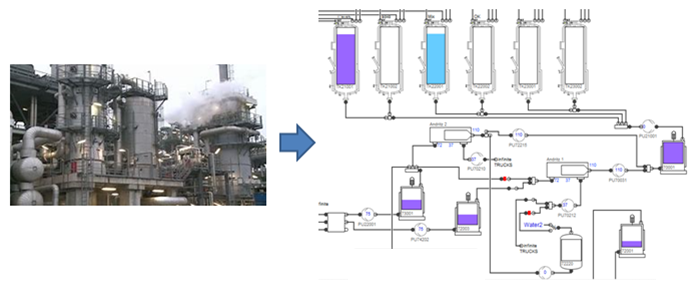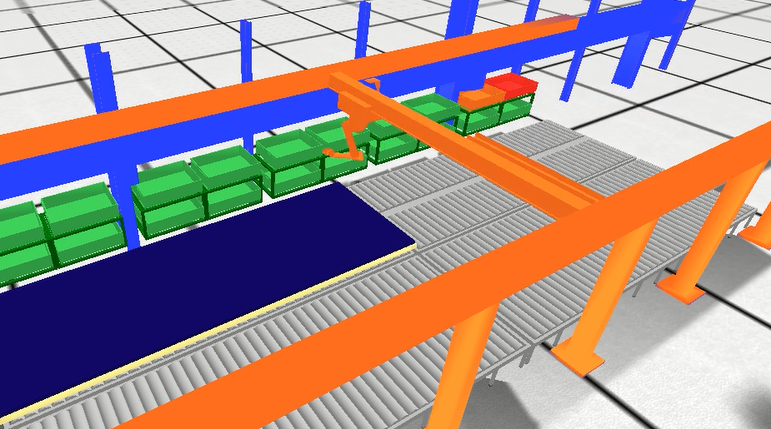In times when the smallest device in everyday life does its best to produce 3D animation, one could think the question has its final answer: 3D animation is necessary in discrete simulation of complex systems, and requested by everybody.
Already twenty years ago* this was a discussed issue, and I remember how we commented ironically: "how long can one really stay watching a simulation moving on the monitor? It is not a TV program!". Some of the arguments of that time remain quite true, with first this triple question: "what effort, what money, what time are you ready to spend for the 3D animation of your model?".
2D or 3D?
You always have to pay for 3D animation: when purchasing the software to start with; when learning the special features to be able to set things nicely; when spending hours on every model for adding the required “3D layer”; in the simulation duration running replications of the model, that will probably need a powerful computer like with video games. 3D animation is not an implied byproduct of flow simulation, just like grated cheese is not essential to gratin dauphinois.
And still, 3D animation is nice and beautiful, we do need it: for presenting the model, for communicating with others about it, for a quick and intuitive understanding of what’s going on!
Stop: you need an animated model, but 2D animation or 3D animation? 2D animation does give immediate visual feed-back of what is happening during a simulation, and is appreciated by the modeler during the final stages of model-building, as well as by the end-user to better grasp the global behavior of the system.
In most simulation programs 2D animation does provide but a simple rendering, with color dots or squares showing or moving, levels going up and down, figures updating. But the amount of information provided is important, and may, if correctly implemented, give about flows some synthetic results altogether useful, thorough, precise and significant.
Significant, but not with the realism offered by 3D, this recognition feeling when seeing the familiar system, so important for the acceptance of the final customer, this flexibility navigating within the model like in the real world, this image of high-end professionalism given by a well-designed 3D animation. I am specifically remembering some conveyor models: wow, that’s neat, you just believe you’re there, nothing was forgotten!… On the other hand some simulation cases can do without 3D animation more easily than others.
3D when mandatory
In some production systems, all important movements are at a same horizontal level and may very well be understood seen from above in a scaled representation. In various chemical processes, a logical diagram representing the batch reactors, how filled they are, and the different stages of production will give more relevant information than a 3D representation of intricate ducts relating tanks of all shapes and sizes.

For many manufacturing systems, I consider that a two-dimensions representation (or even a flowchart), not respecting the real geometry of the system, is not only easier to implement than a 3D animation, but also more adequate.
Clearly for other systems, we are confronted to tridimensional issues, and the 3D animation is obviously more adapted. Such is the case for example of manufacturing sites with several floors, or vertical storage systems including shelves and multi-axis robots.

In some other cases, what is important is not the 3D but the representation of the system on a map: we mentioned this about model layout using GoogleEarth.
Animation consistent with the true level of detail of the simulation model
In fact I believe that the animation of a simulation model, be it in 3D, 2D, or even very schematic, should be consistent with the aims and the true level of details taken into account by the functional model.
For example if the model considers different types of products, it is necessary to associate a color with each type in the model animation. But adding the exact geometry of the product itself has little interest if unrelated to the behavior of the system. Worse, giving an impression of minute details using a very high-level animation when the model itself describes only basic behaviors, seems to me close to intellectual dishonesty.
In our minds animation should give useful information about the model, not be used to manipulate an audience.
In any case, those who really need 3D animation in their discrete simulation model should understand that if it can reveal fruitful, you have to spend something for it…
* Gestion de flux en entreprise : Modélisation et simulation (in French), Paris, Hermès (1996), https://www.eyrolles.com/Entreprise/Livre/gestion-de-flux-en-entreprise-9782866015756